Long story short, I moved about a year ago and hired a farrier that everyone recommended. After a few months I noticed my horse becoming tender footed and every shoe job his angles were quite different and drastic. After being confronted about the quality I found out he moved my horse from a size 1 to a double 00 and he cut off all heel and let his toe go. After a vet visit and new recommendation for corrective shoeing I found this new farrier. He has done my horse 4 times now. (Now I’m paranoid and stay to question every little thing) He has told me he needs to keep pulling the shoe back and roll the toe so he can get some heel support. I keep him on a strict 6 week schedule. He is back to a size 1 with a lot of shaping and extra shoe left. It is now week 5 and I noticed while turned out there was blood on his hoof. Sure enough there is a quarter crack that was bleeding. I immediately called the farrier, due to holidays he is out of town and won’t be back for a few days.
Has anyone seen a crack bleed? I have never dealt this quarter cracks before. Would it be because of the drastic changes? Opinions on the pictures?
This move has been such a nightmare for my poor horse. 




